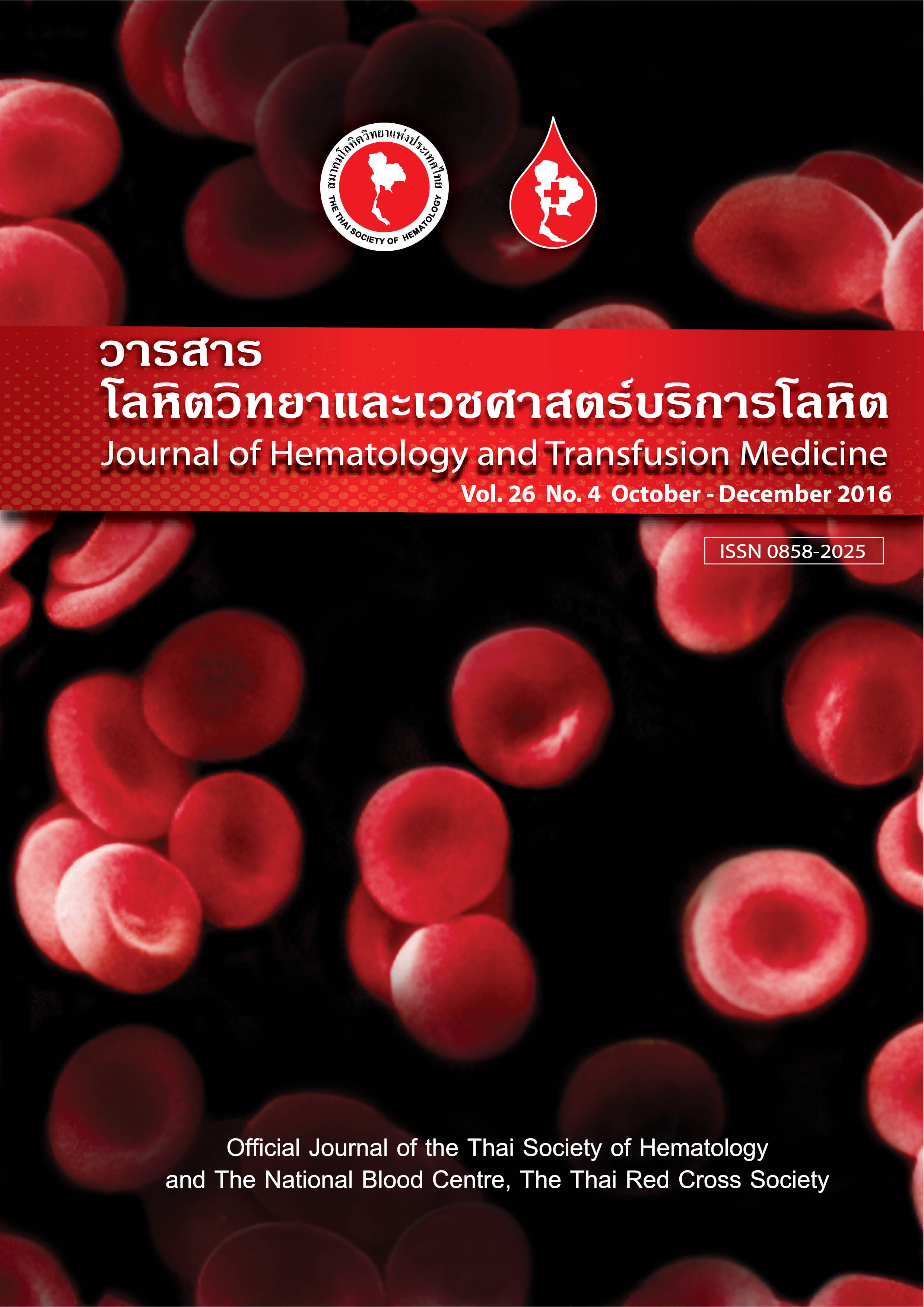Identification of a Rare Alloanti-GP.Hil (Anti-MNS20) in a Thai Patient
Keywords:
Anti-GP.Hil, Rare antibody, Low-incidence GP phenotypesAbstract
Abstract:
A 35-year-old male Thai patient with severe anemia required two units of red blood cells (RBCs). The patient blood group was A, Rh(D) positive and had positive antibody screening. The antibody identification result was inconclusive. Thereafter, the blood samples were sent to the Reference Laboratory of the National Blood Centre, Thai Red Cross Society for further investigation. Antibody identification using in house panel cells demonstrated a suspicion of antibody to low-incidence of glycophorin (GP) phenotypes because two out of three panel cells with MNS7(+) were positive and all were negative with enzyme test. The autocontrol was negative. It was found that two panel cells with positive results were GP.Hil(+); whereas, one panel cell with negative result was GP.Hil(-). The patient RBCs tested with human anti-GP.Hil and found to be negative. Additionally, the patient plasma was also tested with two extra panel cells with GP.Hil(-) and showed negative results. In conclusion, this Thai patient had alloanti-GP.Hil and the GP.Hil(-) phenotype was confirmed. Therefore, two RBCs units of GP.Hil(-) with compatible crossmatch were provided. Interestingly, in a case of unusual antibody identification results suspected of antibody to GP phenotypes, additional testing with extra panel cells of those GP phenotypes and specific antisera is recommended to provide safe blood transfusions for a patient with rare antibody.
บทคัดย่อ
ผู้ป่วยชายไทยอายุ 35 ปี มีภาวะซีดมาก แพทย์จึงขอโลหิต 2 ยูนิตให้ผู้ป่วย ผู้ป่วยมีหมู่โลหิต A, Rh(D) positive ผลการตรวจทั้ง antibody screening และ antibody identification ให้ผลบวกแต่ไม่สามารถสรุปชนิดของแอนติบอดีได้ ธนาคารเลือดจึงส่งตัวอย่างโลหิตให้ฝ่ายห้องปฏิบัติการพิเศษ ศูนย์บริการโลหิตแห่งชาติ สภากาชาดไทยเพื่อตรวจหาชนิดของแอนติบอดี ซึ่งผลการทดสอบเพิ่มเติมกับ panel cells ที่เตรียมเอง คาดว่าผู้ป่วยน่าจะมีแอนติบอดีต่อ low-incidence glycophorin (GP)phenotypes เพราะพบปฏิกิริยาที่ให้ผลบวก กับ panel cells 2 ใน 3 รายที่เป็น MNS7(+) โดยที่ผล enzyme test ให้ผลลบกับทุก panel cells อีกทั้ง autocontrol ให้ผลลบ สำหรับ panel cells ทั้งสองรายที่ให้ผลบวกนั้นเป็น GP.Hil(+) ขณะที่ panel cells ที่ให้ผลลบเป็น GP.Hil(-) จึงคิดว่าผู้ป่วยรายนี้น่าจะมี anti-GP.Hil ซึ่งเมื่อทดสอบเม็ดโลหิตแดงผู้ป่วยกับ human anti-GP.Hil พบว่าให้ผลลบ นอกจากนี้ได้ทดสอบพลาสมาผู้ป่วยกับ extra panel cells อีก 2 รายที่เป็น GP.Hil(-) พบว่าให้ผลลบเช่นกัน สรุปว่าผู้ป่วยมีฟีโนไทป์เป็น GP.Hil(-) และสร้าง alloanti-GP.Hil ดังนั้นจึงเตรียมเม็ดโลหิตแดงจำนวน 2 ยูนิตที่เป็น GP.Hil(-) และผล crossmatch เข้ากันได้ให้กับผู้ป่วยรายนี้ ในกรณีที่ผลการตรวจชนิดของแอนติบอดีไม่สามารถสรุปผลได้ และคาดว่าน่าจะเป็นแอนติบอดีต่อ GP phenotypes ควรทดสอบเพิ่มเติมกับ extra panel cells ที่ทราบชนิดของ GP phenotypes และแอนติซีรัมที่จำเพาะเพื่อช่วยในการให้โลหิตแก่ผู้ป่วยที่มี rare antibody มีความปลอดภัยยิ่งขึ้น



